Beneath the glitz of tiaras and the grandeur of ancient palaces lies a darker, hidden world—one filled with royal family secrets that have shaped modern monarchies and shocked the world. While royalty is often seen as the epitome of decorum and tradition, behind closed doors exist controversial royal moments, hidden royal truths, and aristocratic secrets exposed that rival any political thriller.
From Britain’s House of Windsor to the royal courts of Denmark and Spain, the 21st century has unearthed secrets that have led to royal reputation damage, fierce palace drama, and questions about the future of Europe’s most storied families.
British Royal Family Secrets: The House of Windsor Unveiled
The British monarchy, one of the world’s most iconic institutions, has long maintained an image of grace and continuity. But over the past two decades, that image has been repeatedly challenged by shocking royal revelations and scandalous royal behavior.
1. Prince Andrew Controversy: A Scandal That Shook the Crown
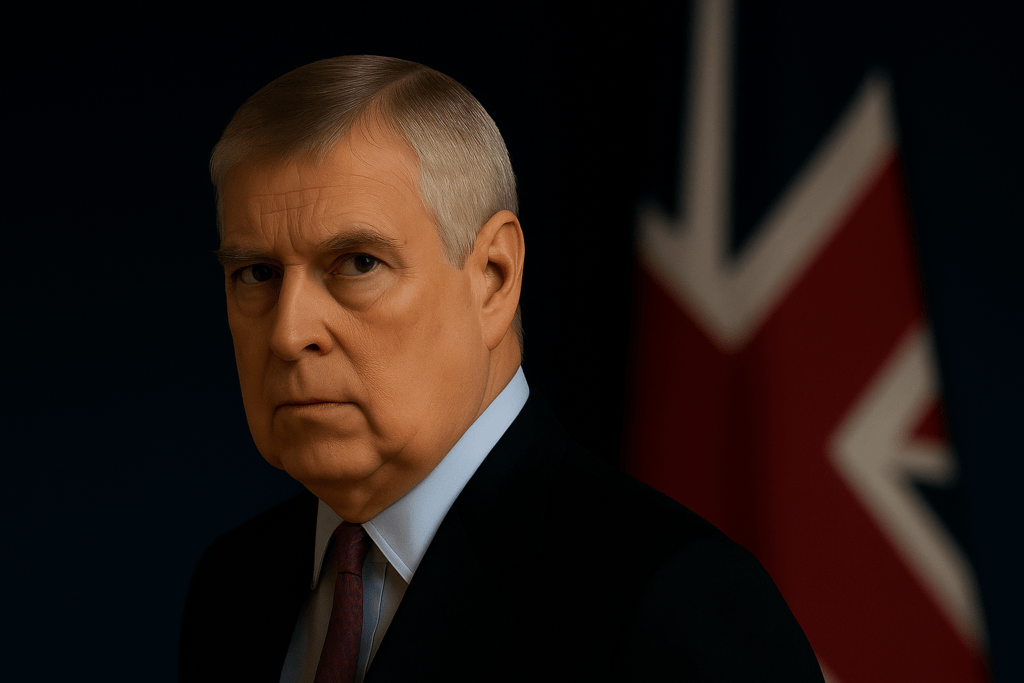
Few scandals in modern history have rocked the British royal family quite like the downfall of Prince Andrew, Duke of York. Once a celebrated naval officer and the Queen’s “favorite son,” Andrew’s public image unraveled rapidly after his association with convicted sex offender Jeffrey Epstein surfaced—a scandal that would soon become one of the darkest chapters in recent royal family secrets.
The controversy first drew public attention in 2015, when Virginia Giuffre (formerly Roberts) accused Prince Andrew of sexually abusing her when she was 17, claiming she had been trafficked by Epstein. Though Andrew denied all allegations, the damage had already begun. The situation exploded in 2019, shortly after Epstein’s death in jail. The public began demanding accountability, and the press unearthed damning connections between Andrew and Epstein—highlighting not only their friendship but also multiple meetings long after Epstein’s first conviction.
Then came the infamous royal family photo scandal: a now-iconic image of Prince Andrew with his arm around Giuffre’s waist, Ghislaine Maxwell smiling in the background. The photo, which Andrew claimed could have been doctored, quickly went viral and became a haunting visual emblem of the allegations. The image remains one of the most circulated royal photos of the 21st century—for all the wrong reasons.
To salvage his reputation, Prince Andrew granted a sit-down interview to BBC’s Newsnight in November 2019. What was meant to be a moment of clarity turned into a PR disaster. The prince denied ever meeting Giuffre and famously claimed he couldn’t have been at the alleged location because he was at a Pizza Express in Woking. He also asserted that he couldn’t sweat due to a medical condition stemming from his time in the Falklands War—an explanation met with widespread ridicule.
The backlash was immediate and brutal. The interview sparked international outrage and further scrutiny of the British royal family scandals. Public trust plummeted. Within days, Buckingham Palace announced that Prince Andrew would step back from public duties “for the foreseeable future.” He was stripped of his royal patronages and military titles in 2022, and his social presence was erased from official royal channels. Though the monarchy has dealt with numerous royal family secrets over the centuries, few were handled as swiftly and decisively as this.
In early 2022, Prince Andrew reached an out-of-court financial settlement with Giuffre, reportedly paying millions without admitting guilt. The settlement’s secrecy only fueled speculation, reinforcing the public’s belief that the truth was being kept behind palace doors. This episode solidified Andrew’s status as a disgraced royal—his future forever clouded, and his role within the royal institution essentially dissolved.
As of today, Prince Andrew lives a quiet, secluded life at Royal Lodge, rarely appearing in public. His presence at major royal events is often deliberately downplayed, and his legacy remains one of the most significant stains on the House of Windsor in the 21st century.
2. The Harry and Meghan Saga: Love, Rebellion, and a Royal Rift
The saga of Prince Harry and Meghan Markle is one of the most dramatic and emotionally charged stories in recent royal history—one that turned Buckingham Palace into the center of a global media storm. What began as a fairy tale between a British prince and an American actress quickly spiraled into a public unraveling of tradition, power, and the personal cost of royalty.
When the couple announced in early 2020 that they would be stepping down from royal duties, it wasn’t just a family decision—it was a global shockwave. No modern royal had ever voluntarily walked away from the privileges and pressures of The Firm so publicly. Their choice to leave behind the royal life, move to North America, and forge a new identity away from the monarchy instantly sparked a wave of media frenzy, family speculation, and harsh tabloid judgment.
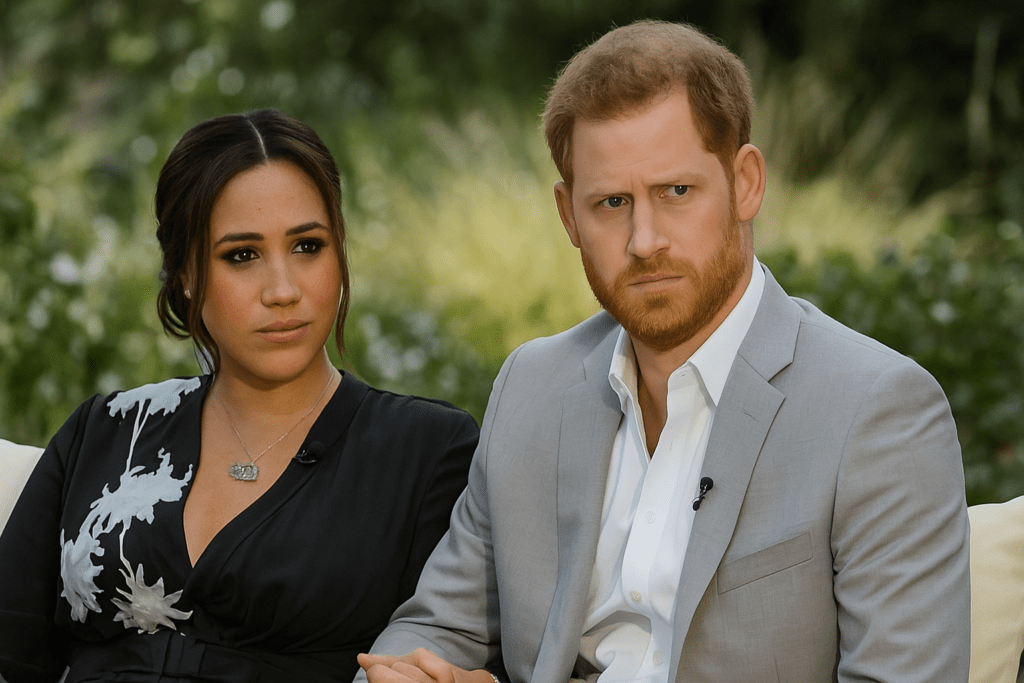
But it was the Harry and Meghan bombshell interview with Oprah Winfrey in 2021 that truly rocked the institution. The sit-down revealed a haunting portrait of life behind palace walls—one filled with emotional neglect, systemic silencing, and racial prejudice. Meghan spoke candidly about suicidal thoughts and her desperate attempts to seek mental health support, only to be allegedly denied help by the Palace. Even more explosive were the claims that unnamed royals had expressed “concerns” about how dark their son Archie’s skin might be—a moment that ripped open centuries-old wounds about race, class, and tradition in the royal household.
The revelations didn’t just hint at British royal family scandals—they openly called them out. Viewers around the world were stunned by the couple’s composure and courage as they peeled back the polished façade of the monarchy, exposing age-old rules that governed everything from wardrobe to speech to motherhood. Allegations that certain documents and correspondence had been suppressed to protect others, while Meghan was left unprotected, further deepened the narrative of betrayal.
The royal family controversy only intensified in the months that followed. Buckingham Palace issued a carefully worded response: “Recollections may vary,” but the silence from senior royals spoke volumes. Prince William was visibly rattled when pressed by reporters, publicly denying that the royal family was racist. Yet for many, the damage had been done. The cracks within the monarchy were no longer hidden behind palace gates—they were playing out on international television.
Underlying the drama was a powerful but often overlooked theme: forbidden royal romances. While Harry and Meghan were legally wed, their relationship defied every conventional expectation—racial, national, cultural, and media-based. Meghan wasn’t just a commoner; she was a divorced, biracial, outspoken American actress. For an institution so steeped in tradition, her very existence was revolutionary. The tension between love and legacy—between Harry’s devotion to Meghan and his duty to the Crown—became a modern-day tragedy.
Over time, familial breakdowns only grew more visible. Harry’s relationship with his brother, Prince William, once unbreakable, appeared frozen. Their once-close bond became a silent standoff. Meghan’s ties with the royal family dissolved almost entirely, and her relationship with Kate Middleton—long speculated as strained—was confirmed to have been misrepresented in tabloids. Even King Charles, Harry’s father, was portrayed as emotionally distant, a man caught between fatherhood and monarchy.
Despite all the turmoil, Harry and Meghan have reinvented themselves in California, becoming advocates for mental health, racial equity, and storytelling through their Archewell Foundation and media ventures. Yet their saga remains one of the most defining royal family controversies of the modern age—one that continues to shape how the world views royalty, tradition, and the price of speaking one’s truth.
The Diana Files and Camilla Affair: Love, Betrayal, and a Shattered Crown
Few figures in modern history command the emotional weight that Princess Diana still holds. Her story wasn’t just a fairy tale gone wrong—it was a deeply human tragedy unfolding inside gilded palaces. While the world saw her as the “People’s Princess,” Diana herself battled emotional suffering, isolation, and a marriage riddled with deceit.
Her televised confession in the 1995 Panorama interview was earth-shattering. In her now-iconic words—“There were three of us in this marriage, so it was a bit crowded”—Diana directly confronted the decades-long Camilla Parker Bowles affair that had haunted her relationship with Prince Charles. For the first time, a royal spouse had publicly challenged the sanitized image of a monarchy built on duty and discretion.
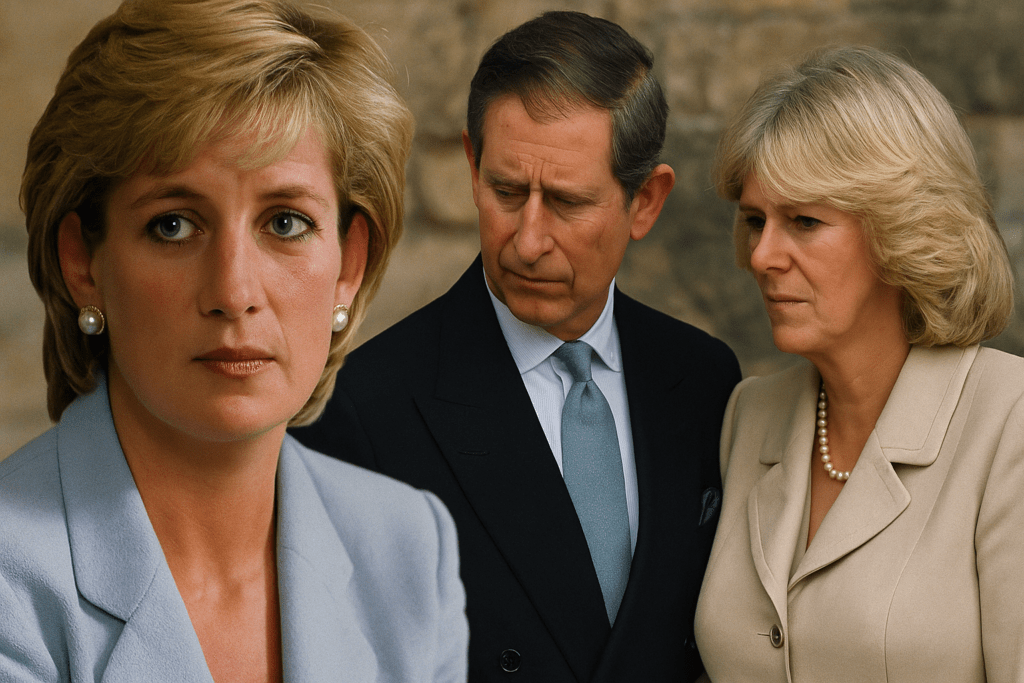
But the drama didn’t end with divorce. Following her tragic death in 1997, a wave of Princess Diana conspiracy theories surged—allegations ranging from covert plots to questions about the role of the paparazzi and security services. Millions questioned whether Diana, a woman who knew too many royal family secrets, had been silenced.
Over the years, newly released tapes, hidden correspondence, and personal testimonies have painted a darker picture of how the royal institution treated her. Diana hinted at concealed royal illnesses, described herself as emotionally discarded, and alluded to how mental health struggles were ignored or downplayed within palace walls.
The Camilla affair, long brushed under royal rugs, eventually culminated in Camilla’s official marriage to Charles—and her gradual acceptance into public life. Yet, for many, her presence remains a reminder of one of the most painful and monarch scandals in modern British history. Diana’s life and death didn’t just mark the fall of a princess—they exposed a monarchy struggling to modernize and care for its own.
4. Royal Family Photo Scandal: When Pixels Betrayed the Palace
In the age of digital transparency, even royal images are no longer safe from scrutiny. What once seemed like harmless portraits of regal charm and festive warmth soon turned into a full-blown royal family photo scandal—one that questioned the authenticity of the monarchy’s most polished public face.
It began subtly—with eagle-eyed netizens noticing inconsistencies in lighting, hand placements, and facial proportions in official royal photographs. Soon, accusations swirled around the royal Christmas card photo scandal, where sharp viewers spotted strange edges and anomalies that suggested digital tampering. What should have been a symbol of family unity turned into a spectacle of suspicion.
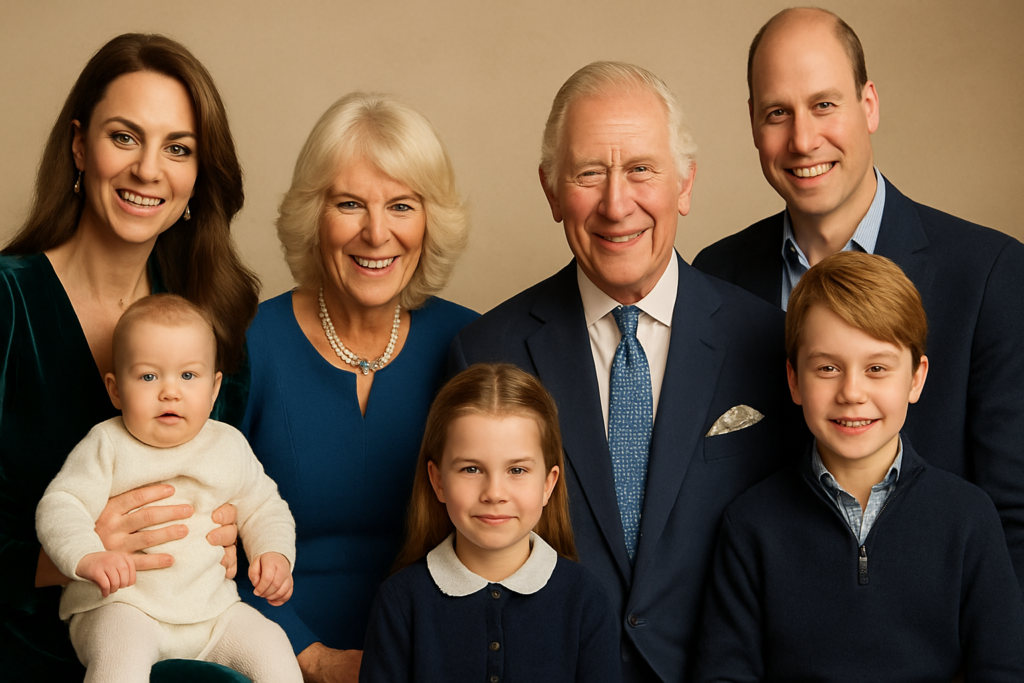
Then came the royal baby photo manipulation controversy. Images released to celebrate milestones of young royals were accused of being overly staged or subtly edited to erase natural flaws. These weren’t just harmless edits—they raised alarm bells about the Crown’s obsession with image over authenticity.
Despite the Palace’s firm denial of any photo editing, the public backlash intensified. In an era when transparency is expected even from the elite, the idea that royal photos might be digitally enhanced struck a nerve. Critics argued that the monarchy’s reliance on perfection only deepened crown controversies, suggesting a disconnect between royal life and the real world.
What was once a harmless tradition—sharing family portraits—had now become a battlefield of trust. In many ways, the royal image manipulation scandals reflected a deeper question: If even a smile can be photoshopped, what else is the monarchy hiding?
5. Prince Harry Memoir and King Charles Controversies: A Kingdom Unveiled
When Prince Harry’s memoir, Spare, was released, it wasn’t just a royal tell-all—it was a revolution in hardcover. Never before had a member of the royal family opened the palace gates so widely and so boldly. The book peeled back centuries of tradition to reveal the bruises, heartbreaks, and brutal realities of growing up royal.
Harry described what it felt like to be the “spare”—a title that shadowed every chapter of his life. The Prince Harry memoir detailed deep family disputes, childhood trauma, and emotional neglect. Readers were shocked by his candid tales of military service, drug use, physical altercations (including one with Prince William), and the suffocating pressure of protocol.
But the book also shone a new, sometimes unforgiving light on his father. King Charles controversies, once whispered, were now public discourse. From emotional coldness to his prioritization of public image over paternal connection, Charles was portrayed as a man torn between crown and compassion. His aloofness, combined with past scandals—such as his affair with Camilla and reported lobbying for luxury donations—raised serious questions about the future monarch’s moral compass.
Together, Harry’s revelations and Charles’s icy public image fractured the already fragile royal narrative. Was the monarchy truly a symbol of unity and grace, or simply an ancient system built on sacrifice and silence?
As the book soared to bestseller lists worldwide, it reignited old royal family controversies and introduced new ones. Suddenly, the polished façade of the palace gave way to a more chaotic, deeply personal, and undeniably human royal reality.
🇩🇰 Danish Royal Family Secrets: Calm on the Surface, Turmoil Beneath
The Danish royal family has long projected an image of elegance, minimalism, and modern sensibility—often hailed as one of Europe’s most stable monarchies. Yet beneath the polite smiles and state banquets, Denmark’s monarchy has become the scene of growing unrest, buried tensions, and a quiet storm of family disputes.
Unlike Britain’s headline-grabbing royals, the Danes have maintained their scandals with Nordic subtlety. But recent developments—ranging from revoked royal titles to whispers of favoritism—have revealed that even in Denmark, the crown weighs heavy with secrecy.
1. Queen Margrethe Controversy: A Modern Throne Divided
In a move that stunned both royal watchers and Danish citizens, Queen Margrethe II—Europe’s longest-reigning monarch—announced in 2022 that four of her grandchildren would lose their royal titles. Her stated reason? To streamline the monarchy for a modern age.
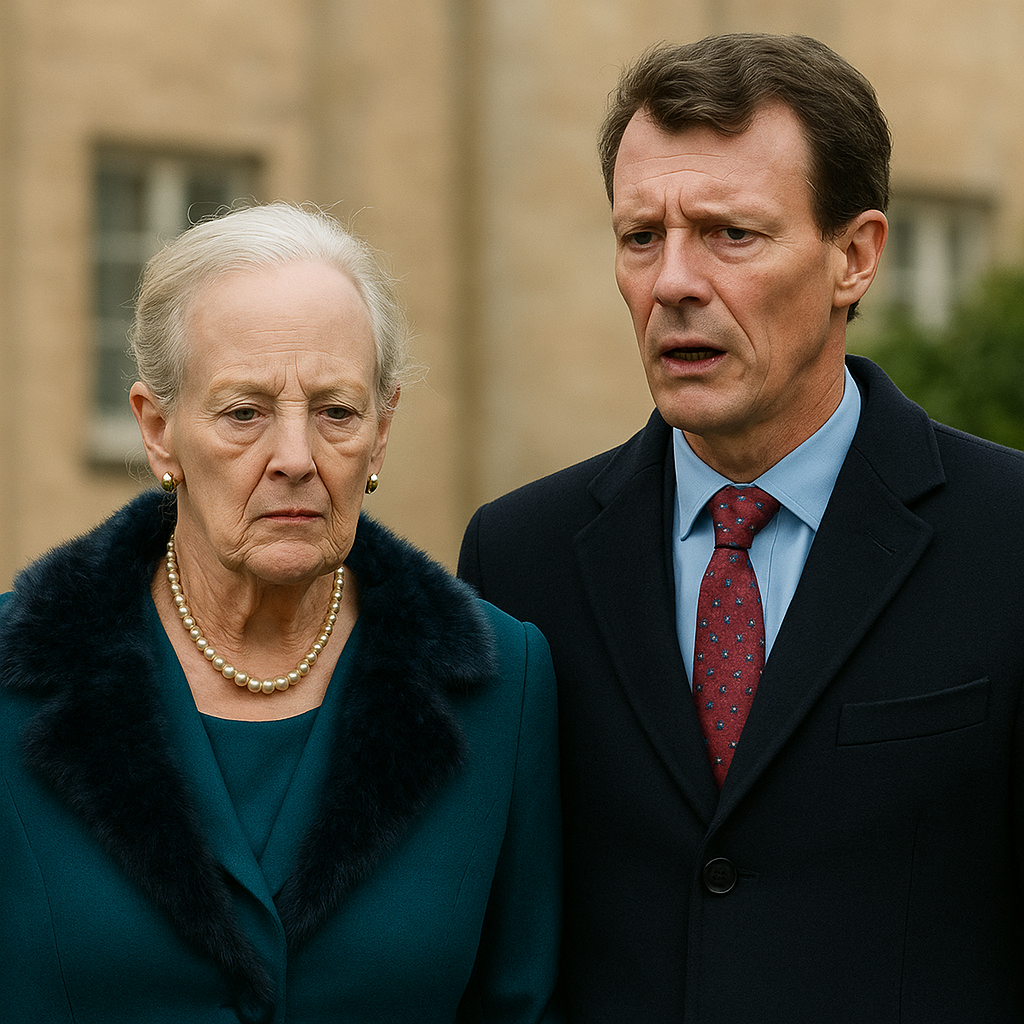
But this was no quiet administrative change. The decision exploded into a Danish royal family scandal. Prince Joachim, the Queen’s younger son and father to the affected children, responded publicly with shock and visible sorrow. In emotionally charged interviews, he accused the palace of blindsiding his family and leaving his children feeling like outcasts. His wife, Princess Marie, echoed those sentiments, further fueling the family rift.
What appeared as a clean constitutional reform quickly spiraled into a palace drama of hurt feelings, cold communication, and unresolved resentment. The Queen later issued a rare apology—not for her decision, but for how it was handled. This only deepened speculation about hidden royal truths and power dynamics behind palace walls.
Was this really about modernization—or was it a veiled reshuffling of influence within the Danish crown?
2. Princess Mary and Countess Alexandra: Quiet Rivalries in a Tense Court
At the heart of Denmark’s refined royal stage lies a web of interpersonal complexity, particularly involving Princess Mary, the Australian-born future queen consort, and Countess Alexandra, the ex-wife of Prince Joachim.
While Princess Mary has long been adored for her poise and charitable work, scandal rumors have quietly swirled around her growing influence in palace decisions. Insiders and tabloids alike have questioned whether her elevated role has impacted royal family dynamics—especially following the Queen’s controversial title revocations, which seemingly elevated Mary’s children while sidelining Joachim’s.
Meanwhile, Countess Alexandra has remained a compelling and sometimes controversial figure in Danish public life. Despite her divorce from Joachim in 2005, she has continued to receive state funding and retain public visibility. Her outspokenness and subtle critiques of the monarchy have raised eyebrows—and stirred comparisons to more outspoken ex-royals elsewhere in Europe.
Some observers whisper of silent rivalries between Mary and Alexandra, reflecting an underlying friction between Denmark’s modern royal image and the more traditional, dynastic expectations within the family. Beneath the smiling family portraits lies a court balancing tradition, change, and interpersonal tension.
3. Denmark Monarchy Drama and Succession: A Crown at a Crossroads
The royal titles controversy was not merely a personal matter—it ignited broader debates about the future of the Danish monarchy. Questions about royal succession, favoritism, and reform took center stage in Danish media and public discourse.
Critics argued that the title revocation unfairly diminished Joachim’s branch of the family while consolidating power around Crown Prince Frederik and Princess Mary. Others defended the Queen’s decision as a necessary step toward trimming the monarchy to ensure its survival in the 21st century.
What’s most telling is the tension between generations: Frederik, poised to inherit the throne, has remained largely silent, while his younger brother, Joachim, has moved abroad, hinting at royal exile and estrangement. The symbolism is hard to ignore.
Denmark’s monarchy, once considered the epitome of quiet royalty, now finds itself navigating modern royal reforms through a lens of emotional fallout, succession questions, and public scrutiny. It’s not just a change in titles—it’s a recalibration of legacy, loyalty, and who truly gets to wear the crown.
🇪🇸 Spanish Royal Family Secrets: From Revered to Reviled
Once hailed as the monarchy that rescued Spain from dictatorship and ushered in democracy, the Spanish royal family is now embroiled in one of the most dramatic falls from grace in modern European history. Behind the balcony waves and gilded ceremonies lie decades of scandal, secrecy, and broken public trust.
The monarchy—once a symbol of unity—is now a household name for controversy, with the throne tarnished by corruption scandals, family betrayals, and a deepening crisis of legitimacy. From a king in exile to courtroom dramas and whispered palace rivalries, the House of Bourbon is learning the hard way that royal secrets never stay buried for long.
1. King Juan Carlos: From Savior to Scandal
King Juan Carlos I was once celebrated as the architect of Spain’s democratic rebirth after Franco’s dictatorship. But in a shocking twist, the man who once stood as a national icon now lives in self-imposed exile—a symbol of the very corruption he once opposed.
The downfall began with investigations into hidden offshore accounts, mysterious financial gifts from Saudi Arabia, and alleged multimillion-euro kickbacks tied to a high-speed rail project in Saudi Arabia. These revelations detonated what’s now known as the King Juan Carlos corruption scandal—a saga that stunned both the Spanish public and the global press.
The former king’s abrupt departure to Abu Dhabi in 2020 did little to ease tensions. While the palace maintained it was a voluntary exile to protect the monarchy, critics saw it as a strategic escape from legal and moral accountability. The incident sparked a full-blown Spanish monarchy crisis, forcing King Felipe VI to renounce his father’s inheritance and publicly distance the crown from the shadow of scandal.
But the damage had already been done. The once-beloved monarch now lives in disgrace, and the Spanish crown remains under the weight of unanswered questions and buried royal truths.
2. Princess Cristina and Iñaki Urdangarin: The Trial That Shattered Illusions
If King Juan Carlos’s scandal cracked the monarchy’s foundation, the Princess Cristina embezzlement scandal sent tremors through the palace walls. For the first time in modern Spanish history, a member of the royal family stood trial—Princess Cristina de Borbón, the king’s daughter, accused of tax fraud linked to her husband’s massive embezzlement scheme.
Her husband, Iñaki Urdangarin, a former Olympic handball player, was found guilty of siphoning millions in public funds through a nonprofit foundation. The revelation of Iñaki Urdangarin’s corruption—disguised behind charity events and sports programs—shocked a nation already wary of political elites.
Though Cristina was ultimately acquitted, her public image never recovered. The trial aired dirty royal laundry, revealing hidden financial networks, secret emails, and a shocking level of complicity. The couple’s fall from grace stripped the royal family of its “untouchable” aura and fed growing republican sentiment across Spain.
The monarchy, once cloaked in mystique, now seemed frighteningly human—flawed, divided, and deeply entangled in greed.
3. Queen Letizia: The Outsider Within
When Queen Letizia joined the royal family in 2004, she was seen as a breath of fresh air—a self-made journalist with poise, intellect, and the charisma to modernize a stagnant institution. But as years passed, her carefully composed image gave way to a far more complicated reputation.
Behind palace doors, rumors of controlling behavior, alleged power struggles with Queen Sofía (her mother-in-law), and a trail of leaked stories fueled ongoing Queen Letizia controversies. Whispers emerged about her strict influence over her daughters’ upbringing, strained relationships with other royals, and her role in reshaping the inner circle of power.
Some hailed her as a reformer; others labeled her a strategist with a sharp agenda. Her media-savvy persona, once her greatest strength, became a lightning rod for criticism as she maneuvered through a court still anchored in centuries-old protocol.
Unlike many royal spouses, Letizia has remained an enigmatic figure—deeply present yet emotionally distant. She commands the spotlight but often seems isolated within the very family she married into. The Spanish royal court, already rocked by legal trials and exiled kings, now finds itself navigating another layer of palace intrigue: an unelected queen reshaping the monarchy’s public face, for better or worse.
Shocking Royal Revelations Across Europe
Forbidden Royal Romances
Across all three royal families, forbidden royal romances have sparked enormous interest and scandal. From Charles and Camilla’s decades-long affair to unverified claims of secret royal lovers in Denmark and Spain, these relationships often defy aristocratic tradition.
Concealed Royal Illnesses
Princess Diana and Meghan Markle both revealed struggles with mental health that were brushed aside or hidden. These stories shine light on concealed royal illnesses and highlight the pressure of maintaining appearances despite internal pain.
Royal Hidden Lineage and Forbidden Children
Speculation about royal hidden lineage and forbidden royal children has plagued monarchies for centuries. Though rarely confirmed, whispers of these elite family secrets persist, suggesting that what is seen in public is only a small portion of the truth.
Leaked Royal Images and Documents
Whether it’s leaked royal images or unauthorized access to royal diaries and leaks, the digital age has made keeping royal family secrets far more difficult. Scandals have been exposed not through courtiers but through the cloud.
Royal Succession Controversies and The Modern Monarchy
Succession remains one of the most sensitive topics in any monarchy. Royal succession controversies in Denmark, the British monarchy’s evolution under King Charles, and Spain’s trust issues post-Juan Carlos have all made succession planning fraught with tension.
Despite attempts to modernize, scandalous royal behavior and aristocratic controversies seem inevitable. The effort to shield royal mishaps from public view is harder than ever.
FAQs About Royal Family Secrets
Q: What are the biggest royal family scandals in history?
A: Major scandals include Prince Andrew’s Epstein ties, King Juan Carlos’s financial corruption, and Princess Diana’s confessions about her unhappy marriage and emotional distress.
Q: Has the royal family ever addressed photo manipulation claims?
A: In recent royal family photo scandals, including the royal Christmas card photo scandal, the palace has either denied or remained silent on accusations of edited photos, leading to more public backlash.
Q: Why was King Juan Carlos exiled?
A: He went into exile amid investigations into alleged corruption, including offshore bank accounts and questionable foreign dealings.
Q: What are some lesser-known royal family secrets?
A: Some include rumored secret royal lovers, royal diaries and leaks, and speculation about royal hidden lineage and unspoken rules within the palace.
Q: How do these scandals affect public trust?
A: Royal scandals lead to increased skepticism about monarchies, often resulting in lower approval ratings and stronger calls for transparency and reform.
Final Thoughts
Whether it’s staged royal photos or forbidden royal romances, the truth behind monarchy is far messier than tradition lets on. These royal family secrets show us that the crowns and ceremonies are often a distraction from the behind-the-scenes realities of power, rivalry, and deeply human flaws.
Europe’s modern monarchies are walking a tightrope: trying to preserve their legacy while confronting the harsh light of 21st-century scrutiny. From British palace drama to Danish royal succession issues and the Spanish monarchy crisis, the age of regal drama is far from over.